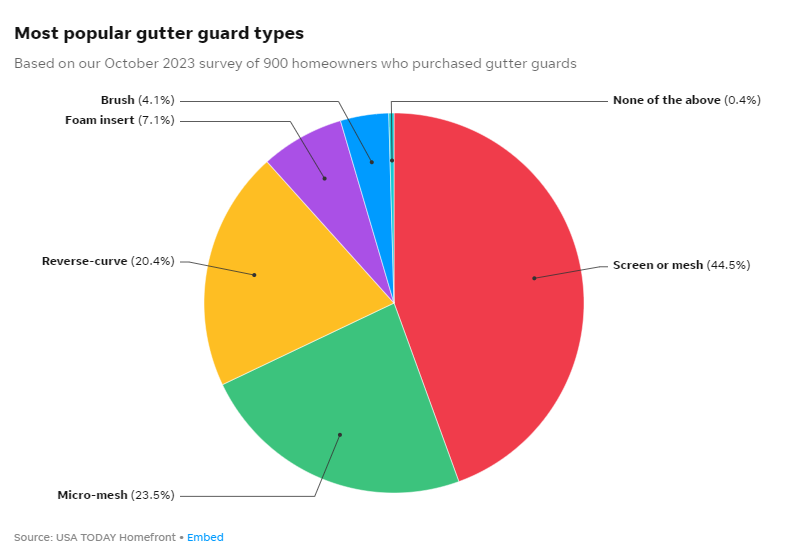
What are gutter covers?
Gutter guards, also known as gutter covers or gutter screens, are devices that are installed over gutters to prevent debris from entering while allowing water to flow through.
What are the benefits?
-
Preventing clogsGutter guards act as a barrier to keep debris like leaves, twigs, and rocks from entering gutters and causing blockages. This allows water to flow freely through the gutter system, reducing the risk of overflow and damage to your home.
-
Reducing cleaningGutter guards can reduce the need to clean gutters multiple times a year, saving you time and money.
-
Preventing rust and corrosionGutter guards prevent wet debris from accumulating in gutters, which can reduce the risk of rusting and corrosion and extend the life of your gutters.
-
Avoiding infestationsGutter guards can prevent rodents and insects from making your gutters their home by reducing standing water and nesting material. They can also act as a barrier to keep animals from squeezing in behind the gutters.
Gutter covers come in a variety of types/styles, here are a few factors to consider when selecting gutter guards:
- Leaf and debris troubles: What kind of trees do you have around your house? Do you get a lot of pine needles, leaves, or roof grit? Different gutter guards work better for different types of debris. For example, if you have a lot of pine needles, a mesh guard with larger holes might be a better choice than a micro-mesh guard.
- Rainfall in your area: Do you live in a place with heavy rain or constant drizzle? Gutter guards with finer mesh might clog up easily in heavy rain. On the other hand, if you live in an area with very little rain, you might be able to get away with a less protective guard.
- Your budget: Gutter guards can vary in price depending on the material and style.
Gutter cover styles/types:
Screen gutter guards
Screen guards resemble a flat sheet perforated with holes. They’re typically made of metal or plastic. They slide on top of your gutters and are held in place by clips or screws.
Screen guards may be a good fit for your home if you live in an area with high winds and deciduous trees. While they won’t stop pine needles from entering your gutters, they can block oak, spruce and other common tree leaves.
Mesh gutter guards
Mesh guards are woven metal or plastic filters that sit on top of your gutters. Many mesh guards have curved lips that allow them to wedge into K-style gutters, making them easy and quick to install. Like screen guards, mesh guards block most large debris, such as leaves, twigs and pine cones.
Micro-mesh gutter guards
Micro-mesh guards are functionally mesh guards with much finer screens. These guards are the most effective and can block even the smallest debris. High-end micro-mesh screens can filter materials while allowing water to pass through with little resistance. Their fine screens handle pine needles better than any other guard type
Reverse-curve gutter guards
Also called gutter helmets, reverse-curve gutter guards resemble large caps that sit atop your gutter system. They use the scientific principles of liquid adhesion and surface tension to push materials off to the ground. This design allows these guards to self-clean, making them one of the lowest maintenance options. These guards could work well for your home if you live in a moderately rainy region. Too little rain and they won’t self-clean, but too much rain and they will overflow. Reverse-curve gutter guards keep most debris, even pine needles, out of your gutters. The quality of the design and materials makes a big difference for these guards, though — more so than for other types.
Brush gutter guards
Brush guards are inserts that resemble large pipe cleaners with a central metal cord and bristles. The bristles catch and trap debris to prevent it from collecting inside the gutter while allowing water to pass through.
These guards are best for you if you want an easy, low-cost installation. They can slide right into your gutter system, making them the easiest to install. They’re an economical option with a low price tag compared to other gutter guard types.
You’ll need to clean brush guards more often due to how they function. During testing, we discovered that materials can get stuck inside the bristles, requiring you to remove sections of the guard to clean it fully.
Foam gutter guards
Foam guards are large blocks that fit snugly inside the gutter system. Their sponge-like material allows water to pass through while preventing materials from getting inside your gutter system. These guards are inexpensive but have the shortest life span. When exposed to ultraviolet rays, the material breaks down over time, and you’ll need to replace them every few years.

